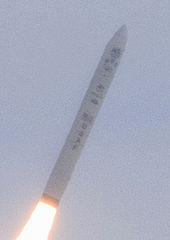Minotaur (rocket)
Minotaur is a US- American missile family , the different versions of which are used both as launch vehicles and for suborbital launches as part of missile defense tests. The Minotaur is manufactured by Orbital Sciences , now Northrop Grumman Innovation Systems. The first launch took place on January 26, 2000. The rockets can be launched from Cape Canaveral AFS in Florida , Vandenberg AFB in California , the Pacific Spaceport Complex - Alaska (formerly: Kodiak Launch Complex) in Alaska, and the Mid-Atlantic Regional Spaceport in Virginia .
Because the Minotaur missiles are based on disarmed intercontinental ballistic missiles (ICBM) owned by the US government, they cannot be marketed commercially and are only available to the US military and NASA .
Versions based on the Minuteman rocket
The Minotaur I is a four-stage rocket - all stages use solid propellants. The first and second stages of the Minotaur are based on the first two stages of the Minuteman II intercontinental ballistic missile (ICBM), which are to be taken out of service under the START I disarmament treaty and are now to be fired as launch vehicles. The third and fourth stages correspond to the second and third stages of the Pegasus XL rocket, respectively . The payload fairing and flight controls are also taken over by the Pegasus XL. In its payload capacity, the Minotaur is 575 kg in a 200 km high orbit, slightly above the Pegasus XL. The Minotaur I was originally called OSP-SLV (Orbital-Suborbital Program - Satellite Launch Vehicle) .
The Minotaur II is a slightly modified Minuteman II missile that is used for suborbital tests of the NMD missile defense system . It is also known as the OSP-TLV (Orbital-Suborbital Program - Target Launch Vehicle) .
Versions based on the Peacekeeper missile
A modified Peacekeeper ICBM, which is also planned for suborbital tests of the missile defense system, bears the name Minotaur III . The Peacekeeper was taken out of service as part of the START II disarmament treaty. This version has not yet been used.
Based on the Peacekeeper-ICBM, an even stronger launcher than the Minotaur I was created under the name Minotaur IV . Minotaur IV is also four-stage, it uses the first three stages of the Peacekeeper and as the fourth stage the third stage of the Pegasus XL. The payload fairing was taken over from the Taurus rocket. The payload capacity of the Minotaur IV is 1,750 kg in a 200 km high orbit.
The first take-off took place as a suborbital flight on April 21, 2010 from Vandenberg, but only in a three-stage variant called Minotaur IV-Lite . The first launch into orbit took place on September 26, 2010.
A variant called Minotaur V with an additional upper stage for higher orbits launched NASA's LADEE moon orbit on September 7, 2013 into a highly elliptical earth orbit, from which the probe maneuvers itself into the moon's gravitational field with the help of its own engines in several earth orbits .
The Minotaur VI is a planned five-stage version of the Minotaur IV for larger payloads.
For the Minotaur-C (formerly Taurus), see there.
The Orion Abort Test Booster (ATB) is a special version of the rocket that was specially developed for launch abort tests with the Orion spaceship . Several launches were originally planned as part of the Constellation program , later only one for the Artemis program . The rocket is based on components from the Minotaur, Taurus and Peacekeeper families. In the US Air Force it is listed as Minotaur IV.
Start list
→ See: List of Minotaur rocket launches
Web links
- Bernd Leitenberger: The Minotaur and Minotaur IV launch vehicles
- Northrop Grumman: Minotaur (English)
- Minotaur in the Encyclopedia Astronautica (English)
Individual evidence
- ^ Air Force space officials prepare to launch first Minotaur IV. (No longer available online.) April 19, 2010, archived from the original on December 11, 2015 ; accessed on September 9, 2013 .
- ↑ Thomas Weyrauch: USAF launches satellite for space surveillance. raumfahrer.net, September 26, 2010, accessed on November 20, 2010 .
- ↑ NASA budget estimate (PDF; 649 kB), page 20
- ↑ Minotaur. Northrop Grumman, accessed March 2, 2019 .
- ↑ Orbital to Provide Abort Test Booster for NASA Testing. Northrop Grumman, April 11, 2007, accessed June 27, 2019 .
- ↑ ATB. In: skyrocket.de. Retrieved June 27, 2019 .
- ↑ 45 th Space Wing Launch Hazard Area. (PDF) US Air Force, June 27, 2019, accessed June 27, 2019 .

